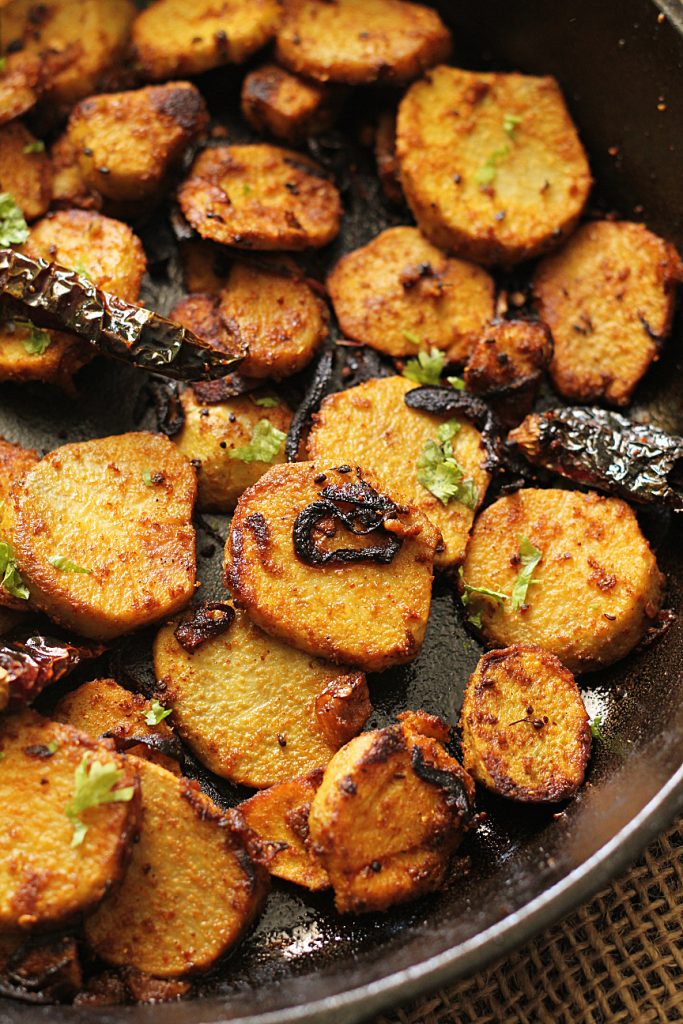
Arbi roast, Cheppankizhangu varuval, taro fry are just a few names given to a simple dish made from the taro/colocasioa root which is shallow fried with a few basic spices. This dish is vegan and can be put together in less than 30 minutes. This preparation was not something I grew up eating as colocasia leaves and not it’s root are an inherent part of Mangalorean cuisine. During my initial attempts with cooking the taro root, I have gone through a struggle to clean the root. Similar to the yam, the taro root has a mucilage that can be itchy when touched due to the presence of calcium oxalate in the plant, as a result of which I used to abandon the mission half way through.

How to stop taro from itching
The known methods of preventing an annoying itch from the taro root is to rub your hands thoroughly with coconut or mustard oil before handling it. If the taro is pre cleaned it will save you the trouble and minimise contact with the root. Should you however end up getting all your hands itchy, try rubbing baking soda and salt over them and rinsing off thoroughly. You may need to do this several times.
Taro – boiled or steamed?
You can boil taro but you need to be around to check doneness or else you may end up cooking it to a mush. This can happen if all the taro roots used are not uniform in size. The best way to cook it is to steam it – this helps retain the texture (without getting it all soggy which happens in the case of boiling it) and nutrients too. Of late, steaming veggies especially root veggies like potatoes, sweet potatoes and carrots and beets has become my favourite method of cooking them.

What does taro taste like?
If you are a fan of root veggies like yam, sweet potatoes and potatoes you are sure to like the taste of taro too. It has the texture of sweet potatoes but without the sweetness and the typical taste. Taro is more versatile when it comes to savoury preparations. While not exactly like yam, I believe it has some similarity in terms of it’s texture – yam that is young and floury/mealy.
This Lent do give this recipe a try and let me know how you like it!


Arbi Roast | Taro Root Fry
Ingredients
- 350-400 grams taro root
- sesame oil
- 2 red chillies
- 1/2 teaspoon carom seeds
- 1/2 medium size onion (finely sliced)
- 1/4 teaspoon turmeric powder
- 1/2 teaspoon red chilli powder
- 1/2 teaspoon cumin powder
- 1/2 teaspoon coriander powder
- 1/4 teaspoon garam masala powder
- 1/2 teaspoon dry mango (amchur powder)
Instructions
- Wash the arbi well. You can then choose to boil or steam the arbi. Boiling method: Place the taro in a pot filled with water (enough to cover them) and boil for 12-15 minutes depending on the size of the arbi. They should be tender but not mushy. Once done, peel, cut into roundels and set aside
- Steaming method: Scrape the peel off and cut into slices. Place in a steamer and steam the arbi for 7-10 mins in a steamer or until it is tender but not mushy when poked
- Heat sesame oil in a cast iron pan and add the carom seeds. When they stop sizzling, add the onions and fry till translucent
- Reduce the heat and add the spice powders powders, salt to taste and fry on a low heat.
- Add the arbi roundels and reduce the heat to a sim. Let them roast for 5-7 minutes.
- Garnish with chopped coriander and serve as an accompaniment to rice and dal
Disclaimer
The nutritional values are only indicative.
Leave a Reply